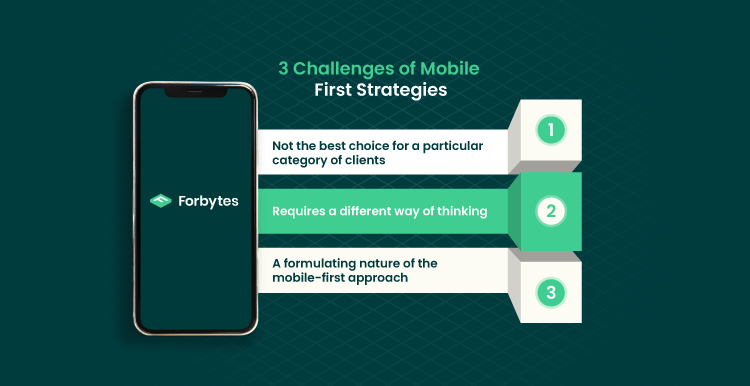What are three things you usually take when you go somewhere? The high chances are that a smartphone will be in this top 3 list. Indeed, modern people are so attached to their mobile phones that they use them nearly in every sphere. From the formal side of life like studying or working to the informal part like chatting or playing games — a mobile phone is a helper everywhere.
Investing in a solid mobile strategy is a winning decision for online retail. In 2021, the number of smartphone subscriptions reached 6.3 billion, compared to 5 billion in 2018. This opens vast opportunities for e-commerce businesses. By adjusting retail to the needs of the mobile audience, you increase their interest in your product. Moreover, you get more ways to stay in touch with your clients and remind them of your special offers.
This article is devoted to the discussion of a mobile-first strategy as the right path for e-commerce development. Let’s dive into stats, reasons, and obstacles on the way to going mobile.
Why Mobile First Strategy? Stats, Facts, & Examples
In 2021, we had more than 4.3 billion mobile Internet users worldwide. Look at how many people live on Earth — 7.9 billion — and you will see what a fascinating figure it is. 9 out of 10 global Internet users access the World Wide Web via mobile, making up for more than a half of total web traffic. And the trend is only growing.
Mobile technology is becoming more affordable and accessible for people in both developed and developing countries. When some expensive device appears on the market, sometime later, developers provide us with a cheaper option with similar functions. That is, mobile technology engineers can satisfy the needs of a variety of users.
Interestingly, 2021 marked the growth of the real mobile revolution intended to completely change the way people treat mobile. In 2021, users spent more than half of their Internet time using mobile devices. The average engagement time was more than 3.5 hours. Here are the main takeaways on mobile usage that these data give us:
- 4.32 billion — the number of unique mobile Internet users;
- 55% — the percentage of total web traffic that comes from mobile;
- 90% — the percentage of the global Internet population who use a mobile device for going online.
These figures cannot be ignored if you want to create a relevant and novel product. Now, let’s check some of the trends that can be useful when considering a mobile-first development.
How Metaverse Concept Can Be Used by Mobile-First Adopters?
Connecting with other people on social media is one of the most engaging activities of mobile. In fact, social media turns people from passive consumers to active and involved users. This can be a great advantage for the adopters of the mobile-first strategy. The complex approach to building a smooth user experience on all platforms, unifying the online representation across different channels, and ensuring the highest user involvement in the interaction with a brand — these are the benefits you may get from the metaverse concept.
In 2021, Facebook announced that the company is rebranding itself into the so-called “meta.” By meta, Facebook meant the metaverse experience to be delivered to the users. Metaverse is a whole new dimension of complex and diverse user experience that can be received in one place. The metaverse presumes the integration of different features and functions with an emphasis on social experience. These include educational and entertaining functions, communication, collaboration, and so on. After Facebook introduced meta, the concept started to grow in popularity.
If you decide to build an e-commerce mobile website, you will get the chance to scale your business up using the basics of meta. Suppose that you have an online website where you sell sunglasses of famous brands. If your website is mobile-focused, you may integrate interesting features into the solution, allowing your users to virtually try on sunglasses to check whether they fit them. The integration of technologies like augmented reality (which is an indispensable part of the metaverse experience) can help you with this goal. You will create a life-like virtual environment and form the basis for a gamified mobile experience. This, in turn, will help you stand out from the competition and make your brand memorable in the client’s mind.
IKEA Case
Even though IKEA is not among the examples of mobile-first websites, this company managed to use the potential of mobile technology to the fullest extent and ensure a flawless user experience.
IKEA was the first global retail business that integrated the technology of augmented reality into their application. And it was a great success. In the first six months of its existence, the IKEA Place app was downloaded more than 13 million times. The app got second place in the rate of the most popular AppStore apps. Below, you may check how it all works. Quite a fun experience, isn’t it?
In fact, this was not the first attempt of IKEA to use the benefits that mobile apps offer to provide a greater service. The company’s IKEA Studio, which is based on augmented reality technology, also enables people to use their iPhones to visualize purchases. Clients can see what their rooms would look like after the purchase by adding furniture or equipment and changing room elements. The customers can even modify measurements and change windows or doors to visualize more complex renovations.
Reasons to Choose Mobile First Approach

1. Set a strong connection with your audience
Mobile-first development approach forms the ground for various user acquisition strategies. From social media marketing to the use of chatbots — such tools help you establish trusted relationships with your audience. According to Manifest, more than half of mobile users check applications on their mobile devices 1 to 10 times per day. More than that, 25% of users check mobile apps 11-20 times daily. This type of client behavior is inherent only to the mobile audience.
If you decide to build a mobile e-commerce solution, you boost the familiarity of your product. Each time when a client chooses among the online stores, the chances are that your e-commerce solution will be their final destination.
2. Reach more clients
As said above, more than half of the global population are mobile phone users. That is, the more opportunities you have on mobile, the more prospective customers you will reach.
The times when a desktop was a favorite tool for accessing the Internet are almost over. In contrast to a desktop, a mobile device is a thing that is always with its owner. If you have a mobile-optimized website, you appeal to the majority of your target audience. If your marketing is designed to meet the flexible needs of mobile customers, you increase the chances for a successful trade.
3. Improve customer experience
User experience is becoming more diverse with mobile-centric strategies. The more effort you invest in improving UX, the more customers love your brand. Apart from selling quality products, you take care of how your audience feels when they buy these products. Such an effort cannot leave your clients indifferent.
Because of the diversity and complexity of parameters, the chances of ensuring a flawless user experience are lower when it comes to a desktop. The risks are that you miss something, and instead of presenting a new interactive function, you will only “present” some bugs. By choosing a mobile-enabled version, you simplify the development process and form the basis for a top-notch user experience.
4. Maintain client focus on the important content
Have you ever come across a website with lots of functions and design elements that it was hard for you to find the action buttons? This is a frequent mistake of businesses that want user attention to focus nearly on every part of their website.
In mobile web design, there is no room for unimportant elements. A user has to focus their attention only on critical information. As a rule, the mobile-first strategy presupposes presenting content in the form of short paragraphs. Such a paragraph consists of 2-3 sentences, which is the usual volume of content a user is eager to focus on while scrolling a page.
5. Get insightful analytics
Mobile e-commerce sites are good for generating rich user data. A mobile web gives customers more freedom. The use of a phone camera, notifications, augmented reality, and social media gives you a better understanding of how your customers behave.
The more you know about your clients, the better personalization you can offer. Data on mobile customer behavior can tell a lot about the favorite functions and tools of your audience, the best time for notifications and ads, the most convenient channels for getting support, etc.
6. Increase loading speed
All these pretty images, interactive elements of mobile design, and gamified effects have an effect on the loading speed of a website. Too long loading decreases conversion and makes lots of prospective clients leave the page even before checking what products it offers. This is why going mobile is so important.
Mobile users do not expect you to impress them with the wonders of technology, as it may be with the desktop audience. Instead, they expect you to lead them strictly to their goal. This adds more opportunities to attract user interest to your product and decreases the development load imposed on your team.
7. Get more SEO opportunities
The more adaptable your solution is, the higher the chances that it will get high search engine rankings. SEO-friendliness is one more benefit of the mobile-first development approach.
A search engine promotes SEO-friendly solutions that implement mobile-first indexing strategies. By choosing a mobile-first approach, you increase the product visibility in search engines.
8. Find new revenue channels
A mobile-first company opens access to new monetization strategies. There are lots of ideas on how you can add monetization to your online business. In addition to selling goods, you can offer more facilitated services.
For example, if you sell clothes, you can build an application where, in addition to buying products, a client will get a chance to schedule a consultation with a stylist. You will offer a more complex service and open new ways of earning money. And even if you already have a web solution, going mobile can become a great way of increasing ROI for all of your channels.

9. Reduce bugs
E-commerce mobile websites are usually more performant because of their simplicity. The simpler the code, the better the performance. There are fewer styling opportunities on mobile, but it does not make it less engaging. Instead, an e-commerce mobile website embodies a laconic and centrist approach to the user experience when there is nothing extra that could distract their attention from the site’s intent. Furthermore, the mobile-first approach to software development prevents bugs when scaling your business up.
Suppose that you start with a web solution and then go mobile. In such a situation, you need to take all these complex pieces of code and reorganize them so that they meet the demand of mobile and preserve the identity and mechanics of your brand. Quite an effort-consuming task, even for experienced e-commerce software engineers. If you decide to start with mobile, it will be much easier for you to move from simple to complex and adjust the code to the requirements of desktop computers.
10. Improve responsiveness
If you decide to adopt a mobile-first strategy for your e-commerce business, you get a more responsive solution in the end. Instead of losing responsiveness when moving from desktop to mobile, you focus on mobile adoption from the very beginning. As a result, customers get a great mobile user experience without compromising on the convenience that could be achieved via desktop but is impossible to transfer to mobile.
Challenges of Mobile First Strategies
As it usually happens, the benefits of building a mobile-first website are more evident than the risks. But you need to consider both to make a rational decision on your business growth. Let’s analyze the 3 most essential drawbacks that are waiting for you on the way to building a mobile-focused software product.

1. Not the best choice for a particular category of clients
Yes, you need to consider general trends while building a product. However, the data on your target client is more important than the unspecified market forecasts. If you know that a mobile-first approach will not work for your business, start with the desktop-first.
There are a few categories of people who prefer using a desktop version for making online purchases. These may include senior citizens who find it more convenient to work on a PC. By using the desktop screen, they get more space for action and a more comfortable picture in case of eyesight problems. So, if you are selling the frames for spectacles and a great part of your clients are senior people, a mobile-first approach may lead to revenue losses. The best way to prevent this from happening is to conduct a study on your target audience before building a product.
2. Requires a different way of thinking
If you decide to start with mobile, the responsibility of choosing a mobile development company doubles. There is a big difference in the way of thinking when developing desktop-first and mobile-first solutions.
When a software engineer starts with desktop-first, they aim to present the maximum on a page and then narrow it to the most important elements if moving to mobile. If you choose a partner that does not specialize in mobile-first development, the risks are that the elements of the website will be organized ineffectively. In contrast to this, mobile-first developers apply a different logic for building a product. They are more limited in space where a product is implemented, which makes them stay laconic and efficient.
3. A formulating nature of the mobile-first approach
Mobile screens are much smaller compared to desktop screens. This is why you cannot expect your mobile-first website to be a space for much creativity. Instead, you need to focus on the most essential elements and the best ways to present them on a small screen. You need to stay selective with what your client will see on your website.
Before introducing some elements, think twice about whether they are vital for inspiring a customer to make a purchase. If you have too many creative ideas in your mind, you need to either choose a desktop-first approach or keep them for the moment when you decide to scale up to a desktop.
Give It a Try
In this article, we talked about the benefits and risks associated with a mobile-first approach. As the tendencies and numbers show, a mobile-first strategy ensures high engagement, quick access to a user, and a flawless client experience. But before choosing this strategy, you need to evaluate the impact of possible risks and your ability to cope with them.
To be confident in what you do, start your software development journey with product discovery. This kind of service allows businesses to deeply review and test their strategy before building a product.
Our team can do a product discovery for you. We will study the business context of your project and your target audience to see if the project requirements play well with other factors. Leave us your contact details to discuss your case.

Our Engineers
Can Help
Are you ready to discover all benefits of running a business in the digital era?

Our Engineers
Can Help
Are you ready to discover all benefits of running a business in the digital era?








